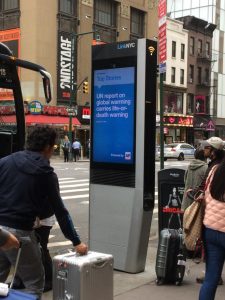New Emergency Infrastructures: An Insight from New York
This blog is published by Dr. Nathaniel O’Grady, who will be joining HCRI as a lecturer in Human Geography and Disasters from January 2019. The blog discusses his recent fieldwork in New York City.
Digital data bear an ever-increasing prevalence across emergency response practices. Amidst an emergency’s real time unravelling, authorities use a variety of devices to communicate in coordinating response. Simultaneously information moves back and forth between and the scene of the event and control rooms often located miles away. Along with appearing as emergencies occur, data are pivotal to facilitating the analysis techniques and detection monitoring through which governments seek to know and manage emergencies as so many risks of a future yet to unfold. Considering such matters seriously can tell us much about how security interventions take on new iterations with technological innovation, how new relations between agencies consolidate and how populations and environments are re-imagined as subjects of governance. It leads us to reappraise some of the most fundamental questions we might ask of security. What forms of knowledge become mobilised in the security apparatus? In what ways do we figure as subjects of the modes of governance instantiated? At a broader register still, what does the capacity of data to capture emergencies tell us about how governments must adapt to attend to the indeterminate anthropogenic processes that, for decades and centuries to come, will constitute life on planet earth?
These issues and questions guided my recent fieldwork in New York where not only are new data becoming actionable but entirely new infrastructure is being installed at quite an astonishing rate. Borne from Mayor de Blasio’s campaign pledge to ‘renew’ public communications services by replacing street payphones with WiFi access at no up-front cost to denizens and tourists alike, the infrastructure I’m referring to is called LinkNYC. Appearing at spots across the five boroughs of the city since 2016, Links are 7 foot chrome monoliths that contain modems supplying an internet connection, a tablet for people to interface with and two 55 inch advertising screens on either side. Links were the design of a public-private partnership between the City of New York and a conglomerate of companies collectively known as CityBridge. CityBridge has paid for everything involved in the installation and maintenance of the Links, meaning the city does not have to use scarce resources to supply free WiFi to millions of people. Instead the WiFi is subsidised by the millions of dollars CityBridge makes using the prime real estate in which Links are located to advertise various products on its screens. Indeed, as part of its ongoing legal commitment, CityBridge has promised to pay the city $500 million over 12 years for the privilege of operating LinkNYC.
The vast majority of content one will see changing every 15 seconds on the Link screens plotted every 150 metres up 5th Avenue is advertising. However, the operators of Links are aware of the need to integrate these devices into the broader experience and communities within the city. To this end, one will also see house content on the screens too. As internally subsidised messages representing different aspects of the city’s daily life, this content includes facts about particular neighbourhoods, weather reports and traffic updates. When circumstances demand it, the Links are used as emergency warning devices to communicate with the public concerning events ranging from localised flooding and storms to fires and terrorist incidents. In the period preceding an event, Links will project predictions on the time it might sweep across the city, the extent of its coverage and its likely impact on various infrastructure. During the event, the 55 inch screens might instruct citizens on evacuation procedures, supplies they might need or precautionary actions to take in stemming an event’s ability to cascade.
With the capacity to operate in myriad ways, Link NYC tells us much about how emergency warning and communication systems might come to operate where Big Data and ‘free’ WiFi rises to prominence and new data-ready street furniture becomes a normal aspect of urban life. It points, for instance, to how responsibility for the provision of security might become more diffuse. Where data plays an increasing role in emergency response, it is not only traditional security-contractor firms that warrant our attention but digital infrastructure providers and software developers working across an array of industries. LinkNYC’s emergency messaging system was co-produced by a local government department and an advertising company. Now fully up and running, the emergency warning mechanism is operated predominantly by the ad firm autonomously. This might appear as a banal fact, but it means that the ad firm thus take an active role in deciding when thresholds are breached for oncoming emergency events and at what point an event’s occurrence should be disseminated as common knowledge. The case also illuminates new forms of redeployment, where communication techniques from the ad world are reapplied to the domain of security. According to the nature of the event, for example, different colour backgrounds will accompany emergency messages to evoke particular reactions out of its beholder. Similarly, publicly-accessible open data platforms find new usages as staff in the ad firm draw upon them to develop strategies for communicating with the public about the next emergency event. On a different note, it’s important to point out that Links, like other technologies associated with smart urbanism, are scalable. That is, they are malleable and can be adapted according to need. If an emergency is confined to one neighbourhood, only a cluster of Links within the immediate proximity will warn of the event ongoing. A smaller network of Links, in other words, can be created within the wider Link network. Alongside introducing new security actors and the techniques they bring along with them, Links demonstrate new ways that security practices actually produce space within the city itself.
Whilst by far the biggest example exists in New York, the company behind them are busy establishing wide networks across other cities in the U.S too. At the same time, a small cluster has emerged in a number of UK cities and, sure enough, keen eyed Mancunians will have noticed a chrome monolith appear near Piccadilly Gardens. As the network extends, we should expect the complicity of this free WiFi infrastructure in matters of security to extend, making it all the more important to examine and understand their applicability and the geo-political stakes that emerge with them.




0 Comments